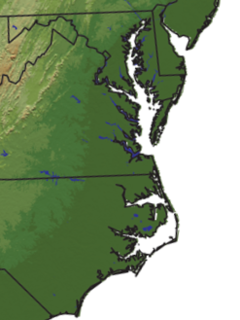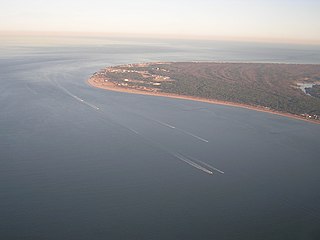Related Research Articles

Cecil County is a county located in the U.S. state of Maryland at the northeastern corner of the state, bordering both Pennsylvania and Delaware. As of the 2010 census, the population was 101,108. The county seat is Elkton. The county was named for Cecil Calvert, 2nd Baron Baltimore (1605–1675), the first Proprietary Governor of the Province (colony) of Maryland. It is part of the Philadelphia-Camden-Wilmington, PA-NJ-DE-MD Metropolitan Statistical Area. Cecil County has existed since the late 1600s, though it continued to grow in population and town size. The county is located in Wilmington's Radio Market and Philadelphia's Designated Market Area.

The Chesapeake Bay is the largest estuary in the United States. The Bay is located in the Mid-Atlantic region and is primarily separated from the Atlantic Ocean by the Delmarva Peninsula with its mouth of the Bay at the south end located between Cape Henry and Cape Charles. With its northern portion in Maryland and the southern part in Virginia, the Chesapeake Bay is a very important feature for the ecology and economy of those two states, as well as others surrounding within its watershed. More than 150 major rivers and streams flow into the Bay's 64,299-square-mile (166,534 km2) drainage basin, which covers parts of six states and all of Washington, D.C. / District of Columbia.

The Delmarva Peninsula, or simply Delmarva, is a large peninsula on the East Coast of the United States, occupied by the vast majority of the state of Delaware and parts of the Eastern Shore regions of Maryland and Virginia. The peninsula is 170 miles (274 km) long. In width, it ranges from 70 miles (113 km) near its center, to 12 miles (19 km) at the isthmus on its northern edge, to less near its southern tip of Cape Charles. It is bordered by the Chesapeake Bay on the west, and the Delaware River, Delaware Bay, and the Atlantic Ocean on the east.

Tidewater is a reference to the north Atlantic coastal plain region of the United States of America.

The Southern Colonies within British America consisted of the Province of Maryland, the Colony of Virginia, the Province of Carolina and the Province of Georgia. In 1763, the newly created colonies of East Florida and West Florida would be added to the Southern Colonies by Great Britain until when the Spanish Empire took back Florida.

U.S. Route 301 (US 301) is a spur of U.S. Route 1 running through the South Atlantic States. It currently runs 1,099 miles (1,769 km) from Biddles Corner, Delaware at Delaware Route 1 to Sarasota, Florida at U.S. Route 41. It passes through the states of Delaware, Maryland, Virginia, North Carolina, South Carolina, Georgia, and Florida. It goes through the cities of Middletown, Delaware; Annapolis, Maryland; Richmond and Petersburg, Virginia; Rocky Mount, Wilson, and Fayetteville, North Carolina; Florence, South Carolina; Statesboro and Jesup, Georgia; and Ocala, Zephyrhills, Brandon, and Sarasota, Florida.

The Eastern Shore of Maryland is a part of the U.S. state of Maryland that lies mostly on the east side of the Chesapeake Bay and consists of nine counties, seven of which have Chesapeake Bay coastlines. The region also contains Maryland's only coast on the Atlantic Ocean. As of the 2010 census, its population was 449,226, with just under 8% of Marylanders living in the region. The term "Eastern Shore" distinguishes a territorial part of the state of Maryland from the Western Shore of Maryland, land west of the Chesapeake Bay. The Eastern Shore is part of the larger Delmarva Peninsula that Maryland shares with Delaware and Virginia.

A movie palace is any of the large, elaborately decorated movie theaters built between the 1910s and the 1940s. The late 1920s saw the peak of the movie palace, with hundreds opened every year between 1925 and 1930. With the advent of television, movie attendance dropped and many movie palaces were razed or converted into multiple screen venues or performing arts centers.

Cape Henry is a cape on the Atlantic shore of Virginia located in the northeast corner of Virginia Beach. It is the southern boundary of the entrance to the long estuary of the Chesapeake Bay.

A showboat, or show boat, was a floating theater that traveled along the waterways of the United States, especially along the Mississippi and Ohio rivers, to bring culture and entertainment to the inhabitants of river frontiers. Showboats were a special type of riverboat designed to carry passengers rather than cargo, and they had to be pushed by a small towboat, also known as a pusher, which was attached to it. Showboats were rarely steam-powered because the steam engine had to be placed right in the auditorium for logistical reasons, therefore making it difficult to have a large theater.
The tobacco colonies were those that lined the sea-level coastal region of English North America known as Tidewater, extending from a small part of Delaware south through Maryland and Virginia into the Albemarle Sound region of North Carolina. During the seventeenth century, the European demand for tobacco increased more than tenfold. This increased demand called for a greater supply of tobacco, and as a result, tobacco became the staple crop of the Chesapeake Bay Region.

USS Alsea (AT-97) was an Abnaki-class of fleet ocean tug. It was named after the Alsea Native American tribe in Oregon.
Ocean Highway was a designation established early in the 20th century for a combination of roadways and water-crossings for motor vehicles which would generally traverse as close as possible to the Atlantic Ocean along the East Coast of the United States from Jacksonville, Florida to North Brunswick, New Jersey. The Ocean Highway concept predated the creation of the Interstate Highway System beginning in the 1950s, and in many states the highways and byways of coastal routes from Florida to North Brunswick still carry the name.
America's 11 Most Endangered Places or America's 11 Most Endangered Historic Places is a list of places in the United States that the National Trust for Historic Preservation considers the most endangered. It aims to inspire Americans to preserve examples of architectural and cultural heritage that could be "relegated to the dustbins of history" without intervention.

Wolf Trap Light is a caisson lighthouse in the Virginia portion of the Chesapeake Bay, about seven and a half miles northeast of New Point Comfort Light. It is listed on the National Register of Historic Places.

The Baltimore Steam Packet Company, nicknamed the Old Bay Line, was an American steamship line from 1840 to 1962 that provided overnight steamboat service on the Chesapeake Bay, primarily between Baltimore, Maryland, and Norfolk, Virginia. Called a "packet" for the mail packets carried on government mail contracts, the term in the 19th century came to mean a steamer line operating on a regular, fixed daily schedule between two or more cities. When it closed in 1962 after 122 years of existence, it was the last surviving overnight steamship passenger service in the United States.

Show Boat is a 1926 novel by American author and dramatist Edna Ferber. It chronicles the lives of three generations of performers on the Cotton Blossom, a floating theater on a steamboat that travels between small towns along the banks of the Mississippi River, from the 1880s to the 1920s. The story moves from the Reconstruction Era riverboat to Gilded Age Chicago to Roaring Twenties New York, and finally returns to the Mississippi River.

Reginald Van Trump Truitt was an American zoologist, Army officer, and college lacrosse player and coach. He spent his professional career studying the oyster habitat in the Chesapeake Bay. Truitt founded the Chesapeake Biological Laboratory at what is now the University of Maryland Center for Environmental Science. He also served as the first head lacrosse coach at his alma mater, the University of Maryland from 1919 to 1927. Truitt was inducted into the National Lacrosse Hall of Fame in 1959.

The Atlantic Seaboard Fall Line, or Fall Zone, is a 900-mile (1,400 km) escarpment where the Piedmont and Atlantic coastal plain meet in the eastern United States. Much of the Atlantic Seaboard fall line passes through areas where no evidence of faulting is present.

An oyster buy-boat, also known as deck boat, is an approximately 40–90 foot long wooden boat with a large open deck which serviced oyster tongers and dredgers. Similar in function to sardine carriers, buy boats circulated among the harvesters collecting their catches, then delivered their loads to a wholesaler or oyster processing house. This spared the fishermen the task and its downtime, allowing them to catch more oysters. Buy-boats also bought seed oysters, or spat, for planting in oyster beds.
References
- ↑ "Archived copy". Archived from the original on 2010-12-21. Retrieved 2011-06-18.CS1 maint: archived copy as title (link)
- ↑ C. Richard Gillespie The James Adams Floating Theatre Tidewater Publishers, Centreville, MD, 1991
- ↑ "Adams Floating Theatre Visited Cecil County -". Window on Cecil County's Past. 2019-08-17. Retrieved 2019-08-17.
- ↑ http://www.floatingtheatre.org/ with video